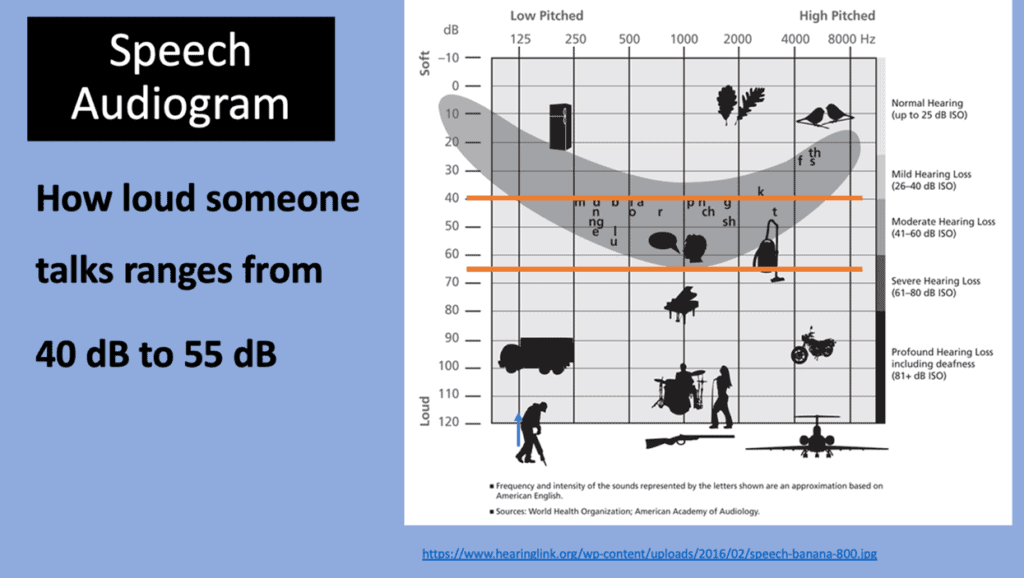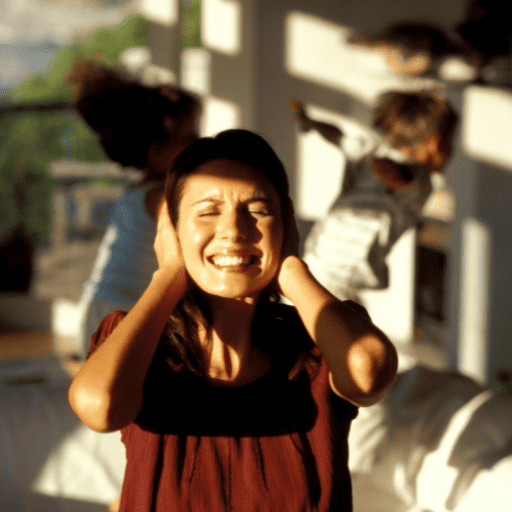Have you ever thought about which sounds are harmful? Everyday common sounds, at home and away from home, can be harmful. Even when you enjoy loud sounds, your body may later provide clues that sounds were too loud. Additionally, sounds affect our mood and behaviors. You can take control of your sound environment. Use the fun apps and charts below to explore your sound environment. Then, design your sound environment to meet your needs.
Conversation and Noise
Whether you live in the city or the country, most of us have experienced the frustration of trying to carry on a conversation in a loud environment. The charts below show you what sounds in our homes and away from home compete with your speech. Have you ever thought about the effects of competing background sounds on your ability to talk fluently? Your really do need to hear yourself talk. Interestingly, our brains must hear what we say to maintain speech fluency. Additionally, loud environments change the tone of our voice. Unfortunately, the louder we talk, the less friendly we sound.
I encourage you to join forces with your loved ones to take control of your sound environment and create fun memories. Protect your hearing and your loved one’s hearing from harmful sounds. I will introduce you to attenuated ear protection that protects your hearing from harmful sounds. Best of all, attenuated ear protection enhances your ability to hear and speak in loud environments. Thus, it is possible to enjoy concerts while protecting your hearing from harmful sounds. The first step is to learn about the meaning of decibel.
Loudness of Speech and Sounds
Decibel is the measurement for the loudness of sounds and speech. First, look at the numbers on the left side of the chart. At the top is the word, soft. The volume of sound is very soft at negative ten decibels. Toward the bottom is the word, loud. Volume increases until the sound is too loud and harmful at 120 decibels.

Now, look at the next chart. How loud do most people talk? According to the American Speech and Hearing Association, whispering occurs around 30 to 40 decibels. Indoors, we talk at a normal volume around 40 to 50 decibels. Outside and during a group conversation, we need to speak a bit louder at 50 to 60 decibels. Then, there is yelling at 65 decibels. See the vacuum cleaner in the picture below at 65 decibels? If you need a bit of time to yourself, vacuuming can give you a break from chatter. Even little one’s know they must wait until you are done.

Clues Sound was Harmful
There are clues from our bodies telling us that sound is too loud. One clue occurs when the environment is finally quiet. Perhaps at bedtime. Despite being in a quiet room, do you hear sounds in your ear? If so, you are experiencing tinnitus. The sounds of tinnitus are numerous. For example, you may hear whistling, buzzing, roaring, ringing, or a high pitch cricket. Learn more from ReSound and Starkey about the numerous causes of tinnitus.
Another clue occurs after you have attended a loud, fun event like a concert. If you struggle to hear what someone is saying, then the sounds were harmful. Perhaps on the way home, you realize you have no idea what someone is saying. You need them to speak louder and slower. This is another clue that was too loud, harmful. Usually, after a quiet night of sleep, you are able to once again listen with comprehension. Over time after repeated exposures to harmful sounds, you will start to experience behavioral characteristics of noise exposure hearing loss.
When hearing loss occurs there is a clue you need hearing aids. The clue is the development of sound intolerance. Sound intolerance can occur gradually or suddenly after exposure to a very loud sound. When you experience decreased tolerance to sounds, you find it more difficult to listen in noisy environments. Competing background sounds, like the vacuum cleaner in the chart above, should make it too difficult to carry on a conversation. However, quieter sounds from appliances, like a refrigerator or birds singing, should be easy to ignore. If you or your loved one becomes distracted by competing background sounds while talking or listening, schedule a free consultation.
What is Your Sound Exposure History?
Interestingly, the degree of discomfort to sounds depends on your ear health and how well you hear. In addition, the loudness and frequency of the sound also impact behavioral responses. Use the chart with one of the phone apps shared in the “Take Action” section to take control of your sound environment.

Printable Safe Listening Habits Decibel Chart
Preschoolers, Children, and Teens
According to The American and Speech Hearing Association, infants, children, and teens hear better than adults. Why? Mostly due to lack of exposure to harmful levels of sound. Did you know that brain development occurs up to age twenty-six? Thus, it is very important to protect brain development by wearing ear protection when there are harmful levels of sounds.
Sadly, researchers found more behavioral difficulties and weaker auditory processing skills in teens and young adults who developed hearing loss when compared to older adults who developed age-related hearing loss. Researchers concluded that since adults acquired developmental cognitive auditory processing skills before acquiring hearing loss, their brains subconsciously filled in missing pieces of information.
A Clue, Listening Becomes Work
A clue sounds were harmful is that trying to listen becomes work. When hearing loss is mild, sounds become distorted. Thus, listening becomes work. Since mild hearing loss is not deafness, loved ones fail to understand. I have learned much by living with a loved one who acquired work-related hearing loss. Even though he recognizes nonsense when he mishears, he still has to interrupt to check for understanding. Then, he chuckles and is ready to resume listening. Basically, hearing loss contributes to auditory processing difficulties for everyone. I am constantly amazed by how much our hearing affects almost every sensory system.
I am very passionate about identifying all types of hearing loss. Why? Because the effects of diminished hearing reduce sensory stimulation to other sensory systems like our vision. Hearing loss negatively affects balance, eye-hand coordination, sound tolerance, depth perception, expressive speech, and learning. Adults, did you know that your hearing helps you maintain your cognitive skills, balance, and instinctive movement?
Today, the importance of protecting your hearing from harmful sounds is understood better than ever before. Unfortunately, appliances and tools within the home and outside the home expose us to loud sounds. Additionally, music and games from iPhones, iPads, and other devices result in earbuds and headphones usage by preschoolers, children, and teens. This may keep our sound environment quieter, but unfortunately, earbuds and headphone usage increase the risk of hearing loss in all ages.
Take Action
Take action, there is no need to guess if your sound environment is harmful to your ear health! The website, It’s a Noisy Planet, Protect Their Hearing, is a program by the National Institute of Health. Learn about their app, NIOSH Sound Level Meter.
Sound Meter is a software program for your computer. After downloading, explore the sound level of environments at home and elsewhere. Measure the loudness of specific sounds and ambient noise.

After you fill out the Decibel Diary, transfer the data to the decibel chart linked below to see if you need to adjust your listening habits.
App Meters
Explore and play with your children and teens using app meters. You can help everyone develop safe listening habits. iPhones and Android cell phones apps identify the loudness of a sound and the safety of that sound. Fun for all ages!
- Explore the loudness of environment sounds with the Android app, Sound Meter.
- The app, Decibel X Pro Noise Meter, is available for Apple devices. Decibel X identifies the loudness and safety of sounds from technology.
- The iOS app, Decibel: db sound level meter, measures the intensity of environmental sound levels and includes a hearing acuity test.
Protect Your and Your Child’s Hearing
Develop new habits to protect your hearing and your child’s hearing. According to The National Institute for Occupational Safety and Health (NIOSH), ear protection should be worn during exposure to sounds above 85 decibels, especially when exposed to loud and harmful sounds day after day. Here is a simple test you can do yourself without technology. If you must raise your voice or find it difficult to have a conversation while operating equipment inside or outside of your home, you need ear protection.
Even though sound disperses more easily outside, your hearing system is very near the equipment you are holding or sitting on. Thus, protecting your ears is always the best choice.
- On Amazon, I found kid-size sound elimination headphones for yard work. The cost averaged about $20.00 dollars with shipping.
- Likewise, adult 35 decibel sound reduction headphones are also affordable averaging about $30 dollars.
- Sound elimination headphones are recommended when firing a gun due to how close you hold the gun to your ears. The cost is about the same.
This is a bargain when compared to the cost of hearing aids. Depending on the degree of hearing loss, the cost of hearing aids is anywhere between two to five thousand dollars. Of course, maintaining your cognitive skills, instinctive movement, and independence is worth the cost of hearing aids. When in doubt, wear ear protection. It is worth the few extra moments it takes to find your ear protection.
Another Clue, Hyperacusis
A very concerning clue that sound was too loud, harmful, occurs immediately after being exposed or years later after repeated exposure to loud sounds. Most people find this clue a bit unbelievable. It will make sense in just a minute. The clue is a lack of tolerance to sounds, sound sensitivity. Also known as hyperacusis.
Have you ever heard sounds tolerated by others, but you covered your ears, cringed, or perhaps even left?

If so, did you conclude you hear too well? Unfortunately, decreased tolerance to loud environments or certain sounds, sound intolerance, indicates either a very weak hearing system or permanent hearing loss. Ear infections, enlarged adenoids, and unknown food allergies or intolerances weaken the hearing system. Exposure to very loud sounds causes permanent damage to your hearing system, hearing loss. Remember, hearing loss is rarely deafness.
Think of what happens when you are unable to walk on a broken leg for months. The muscles weaken. When your leg bones heal and the cast comes off, you can see that your leg muscles are smaller than before you broke your leg. Walking on your weak leg causes discomfort. Likewise, when sounds stimulate weak auditory nerve pathways due to hearing loss, you experience sound intolerance. Does this make sense? Thankfully, auditory integration training programs strengthen the hearing system.
Need More Motivation to Protect Your Hearing?
Do you need more motivation to protect your hearing from harmful levels of sound? Equally important, are you motivated to change your listening habits? When you wear earbuds to listen to music or podcasts, sound energy is unable to travel over skull bones. Thus, you under-stimulate part of the hearing system called the inner ear’s vestibular system. The inner ear’s vestibular system coordinates head, neck, and eye movement. Why is this important?
Think about how older individuals with age-related hearing loss walk. Did you picture a person stooped over, looking more at the ground than standing up straight? The vestibular system helps you walk upright and keep your balance. Thus, a strong vestibular system helps prevent falls. A strong vestibular system is critical for helping people maintain their independence.
Attenuated Ear Protection: Musicians, Builders, Warehouse Workers, & Swimmers
Tru Ear Protections meets the diverse needs of professional musicians, construction workers, and more. Swimmers, protecting your ears from ear infections prevents scarring and damage to your middle ear bones.
Attenuated ear protection decreases the volume of high-frequency sounds while preserving speech frequency sounds. Thus, you can wear ear protection in a loud place and still have a conversation.
Tru Custom Westone Hearing Protection is obtained from an audiologist. Find an approved provider near you who will make your custom earmolds and place an order.
Hope, Strengthen Your Auditory System
Just like physical therapy exercises your muscles to restore movement and decreases pain, iLs and Berard-based in-home auditory integration training exercise middle ear muscles and auditory neural pathways. Thus, over time you experience improved sound tolerance. I am tenacious about making sure there is no hidden hearing loss. Why is this so important? Because past clients with a more difficult to diagnose hearing loss failed to benefit from auditory integration training. Other clients failed to meet all vision therapy goals. The sensory system needs strong stimulation from the hearing system.
In addition, strengthening inner-ear muscles improves stimulation along auditory neural pathways to the brain. Now, sounds from both ears learn to get in-synch. Consequently, strong sound energy can now integrate with information from the vestibular system. Gradually after auditory integration training, what is heard more strongly integrates with what is seen. The next goal is to facilitate instinctive eye and motor movements. Thus, it is important to assess visual processing skills to ensure there are no visual processing difficulties. Now, the client can work at their level of intelligence, gain coordination and balance. Best of all, emotional health improves!
Hearing Loss Behaviors
Normally, hearing loss occurs so gradually individuals subconsciously change their behaviors to adapt. Often, they and loved ones fail to fully understand the full impact of hearing loss. Thus, I created the video, If Only I Had Known How My Hearing Loss Was Affecting My Life on my webpage: Hearing Loss and Sound Intolerance.
Failure to recognize hearing loss behaviors delays an individual’s ability to receive help. When there is sound intolerance, auditory integration training strengthens the hearing system. I have helped several clients with severe sound intolerance successfully transition into hearing aids.
Think of today’s hearing aids as sound adjusters. Hearing aids pair up with cell phones. You can decrease competing background sounds while increasing the sound of the person speaking to you. Best of all, you can make a high pitched tenor voice more comfortable by turning up the bass and turning down the tenor frequency on your phone app.
More Resources
Additional resources are available on the Research Blog, Listening Habits Affect the Safety of Headphone and Earbud Usage; Headphone Usage by Children and Brain Plasticity. These blog posts share what researchers found while tracking the effects of technology changes and the listening habits of teens and young adults in various environments.


